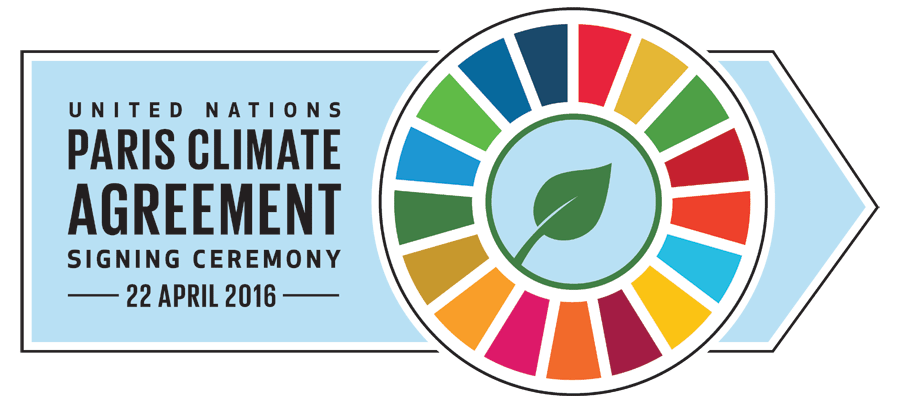पेरिस जलवायु समझौता क्या है?

आपने संभवतः इसका उल्लेख अक्सर सुना होगा, और यह हमारे लक्ष्यों की सूची में सबसे ऊपर दिखाई देता है, लेकिन आप सोच रहे होंगे - पेरिस समझौता वास्तव में क्या है, और यह आपके बगीचे पर कैसे लागू होता है?
22 अप्रैल 2016 और उसके बाद के महीनों में, वैश्विक जलवायु परिवर्तन से निपटने के प्रयासों को मजबूत करने के लिए 197 पक्षों ने पेरिस समझौते पर हस्ताक्षर किएसमझौते का उद्देश्य "इस सदी में वैश्विक तापमान वृद्धि को पूर्व-औद्योगिक स्तरों से 2 डिग्री सेल्सियस से नीचे रखकर जलवायु परिवर्तन के खतरे के प्रति वैश्विक प्रतिक्रिया को मजबूत करना और तापमान वृद्धि को और भी 1.5 डिग्री सेल्सियस तक सीमित रखने के प्रयासों को आगे बढ़ाना है।" इसे प्राप्त करने के लिए, समझौते में सभी हस्ताक्षरकर्ताओं को अपने "सर्वोत्तम प्रयास" या अद्वितीय जलवायु न्यूनीकरण योजनाओं को आगे बढ़ाने की आवश्यकता थी जिन्हें राष्ट्रीय स्तर पर निर्धारित योगदान (NDC) के रूप में जाना जाता है। राष्ट्रों से अपेक्षा की जाती है कि वे आने वाले वर्षों में अपनी सफलता को मजबूत करें और रिपोर्ट करें।
पेरिस समझौते में जलवायु परिवर्तन से निपटने के लिए आवश्यक महत्वपूर्ण पहलुओं की पहचान की गई है, जिनमें तापमान लक्ष्य, उत्सर्जन की वैश्विक चरम सीमा, अनुकूलन और लचीलेपन को मजबूत करना, शिक्षा और जन जागरूकता, तथा अन्य शामिल हैं।
संयुक्त राज्य अमेरिका: प्रतिबद्धता और वापसी
कार्यकारी कार्रवाई के माध्यम से, राष्ट्रपति बराक ओबामा ने 2025 तक 2005 के स्तर से ग्रीनहाउस गैस उत्सर्जन को 26-28% तक कम करने के लिए संयुक्त राज्य अमेरिका की प्रतिबद्धता पर हस्ताक्षर किए। जून 2017 में, राष्ट्रपति ट्रम्प ने पेरिस समझौते से हटने के अपने इरादे का संकेत दिया। हालाँकि, समझौते की संरचना के अनुसार आधिकारिक रूप से हटने से पहले तीन साल की भागीदारी की आवश्यकता होती है। संयुक्त राज्य अमेरिका औपचारिक रूप से ऐसा 4 नवंबर, 2020 तक कर सकता है। संघीय सरकार के हटने के इरादे के बावजूद, कई व्यवसायों, गैर-लाभकारी संस्थाओं, शहरों, समुदायों, संगठनों, विश्वविद्यालयों, धार्मिक समूहों और अन्य संस्थाओं ने अमेरिका द्वारा की गई प्रतिबद्धताओं का सम्मान करने के अपने इरादे का संकेत दिया है।

हम अभी भी अंदर हैं
जून 2017 में राष्ट्रपति ट्रम्प द्वारा पेरिस समझौते से हटने का इरादा व्यक्त करने के बाद, कई शहरों, समुदायों, संगठनों, विश्वविद्यालयों, धार्मिक समूहों और जनजातियों ने पेरिस समझौते से हटने का इरादा व्यक्त किया। हम अभी भी अंदर हैं आंदोलनयह अभियान पेरिस समझौते के मानकों को बनाए रखने तथा जलवायु परिवर्तन को रोकने के लिए कार्य करने की जिम्मेदारी की प्रतिबद्धता की घोषणा करता है। हम अभी भी अंदर हैं यह एक विविधतापूर्ण गठबंधन है, जिसमें द्विदलीय और अंतर-क्षेत्रीय समर्थन है, जो संयुक्त राज्य अमेरिका की जलवायु न्यूनीकरण प्रतिबद्धता को पूरा करने के लिए अपने पर्यावरणीय नेतृत्व का प्रदर्शन करता है। हम अभी भी अंदर हैं गठबंधन रणनीति प्रयासों और प्रशासन का नेतृत्व विश्व वन्यजीव कोष जलवायु नेक्सस और सेरेस द्वारा किया जाता है। 3,900 से अधिक महापौर, सीईओ, राज्यपाल, आदिवासी नेता, कॉलेज अध्यक्ष, धर्मगुरु और अन्य लोगों ने पर्यावरण नेतृत्व की इस भूमिका को निभाने का फैसला किया है। हम जलवायु परिवर्तन से निपटने के लिए अपनी प्रतिबद्धता की प्रतिज्ञा करने की दिशा में पहले कदम के रूप में उनकी संख्या में शामिल होने की सलाह देते हैं।
तीन उत्सर्जन क्षेत्र
कार्बन पदचिह्न की गणना करते समय उत्सर्जन को सटीक रूप से वर्गीकृत करना और ट्रैक करना महत्वपूर्ण है। संगठनों को उनके कार्बन पदचिह्न की गणना करने में मदद करने के लिए एक तीन-स्कोप उत्सर्जन प्रणाली बनाई गई थी। सिस्टम को तीन स्तरों में विभाजित किया गया है, जिन्हें "स्कोप" कहा जाता है, जो इस बात पर ध्यान केंद्रित करते हैं कि ग्रीनहाउस गैसें कहाँ जारी की जाती हैं। पहले स्कोप में सभी शामिल हैं प्रत्यक्ष उत्सर्जन साइट पर जारी किया गया जिसमें ईंधन दहन और खपत शामिल है। गैस बॉयलर और बेड़े के वाहनों का उपयोग, और एयर कंडीशनिंग लीक भी पहले स्तर में शामिल हैं। स्कोप 2 उत्सर्जन में शामिल हैं सभी अप्रत्यक्ष उत्सर्जन ऐसे स्रोतों से जो संगठन के स्वामित्व में हैं या उसके नियंत्रण में हैं। अप्रत्यक्ष रूप से उत्पादित उत्सर्जन में खरीदी गई बिजली, हीटिंग और कूलिंग, और साइट से बाहर उत्पन्न भाप शामिल हैं। स्कोप 3 को निम्न श्रेणियों में वर्गीकृत किया गया है अन्य सभी अप्रत्यक्ष उत्सर्जन संगठन द्वारा की जाने वाली गतिविधियों से संबंधित जिसमें कर्मचारी यात्रा, आवागमन, ठोस अपशिष्ट निपटान, अपशिष्ट जल उपचार, तथा बिजली खरीद के साथ परिवहन और वितरण शामिल हैं। प्रत्येक क्षेत्र में कुछ संगठनात्मक गतिविधियों को रखना प्रभाव को सटीक रूप से मापने के लिए उपयोगी हो सकता है।

अगला कदम: पूर्ण ऊर्जा लेखा परीक्षा
अभिनव समाधान बनाने की शुरुआत एक सवाल से होती है: हम कहां से शुरू करें? उत्सर्जन कम करने के लिए पहला कदम ऊर्जा ऑडिट पूरा करना है। ऑडिट पूरे संगठन में मौजूदा उत्सर्जन और ऊर्जा उपयोग पैटर्न का विश्लेषण करने का अवसर प्रदान करेगा।
आज कई अलग-अलग प्रकार के ऑडिट मौजूद हैं; दो उदाहरण हैं प्रारंभिक ऑडिट जो समय की अवधि पर केंद्रित है या विस्तृत ऑडिट जो ऊर्जा, प्रौद्योगिकी या नियंत्रण बचत के वित्तीय अनुमानों पर केंद्रित है। ऊर्जा मूल्यांकन ऊर्जा दक्षता बढ़ाने और ऊर्जा खपत को कम करने के लिए एक व्यवस्थित दृष्टिकोण है। स्थानीय बिजली कंपनियाँ ऊर्जा उपयोग को कम करने और संकाय प्रौद्योगिकी को बदलने के बारे में सुझावों के साथ ऑडिट समाप्त कर सकती हैं।
जलवायु टूलकिट भविष्य में एक ब्लॉग पोस्ट प्रकाशित करेगा जिसमें ऊर्जा ऑडिटिंग के बारे में गहराई से जानकारी दी जाएगी ताकि आप अपने लिए कारगर समाधान पा सकें। हम आपके संस्थान में आपके उत्सर्जन को कम करने और पेरिस जलवायु समझौते का सम्मान करने में आपकी मदद करने के लिए तत्पर हैं!
यदि आपका बगीचा इस बातचीत में शामिल होना चाहे तो कृपया हमारा सर्वेक्षण डाउनलोड करें और पूरा करें और वापस लौटें ceo@phipps.conservatory.org.
गहन जानकारी: अधिक संसाधन
निम्नलिखित संसाधनों ने हमें यह कहानी लिखने में मदद की। हम उन लोगों को इनकी सलाह देते हैं जो इस विषय पर और गहराई से जानना चाहते हैं।
- ईपीए एक प्रावधान प्रदान करता है ग्रीनहाउस गैस (जीएचजी) उत्सर्जन संसाधन दस्तावेज़ जो ग्रीनहाउस गैसों के स्रोतों, वैश्विक उत्सर्जन, राष्ट्रीय उत्सर्जन, सुविधा-स्तर उत्सर्जन और कार्बन फुटप्रिंट कैलकुलेटर के बारे में बताता है। यह किसी व्यक्ति के कार्बन फुटप्रिंट की गणना शुरू करने के लिए एक उपयोगी संसाधन है।
- जलवायु परिवर्तन पर संयुक्त राष्ट्र सम्मेलन में बताया गया है कि राष्ट्रीय स्तर पर निर्धारित योगदान पेरिस समझौते के प्रत्येक पक्ष को अपने ग्रीनहाउस गैस उत्सर्जन में कटौती के लिए एक रूपरेखा तैयार करनी होगी।
- यह संसाधन ओबामा प्रशासन के दौरान संयुक्त राज्य अमेरिका में जीवाश्म ईंधन के उपयोग और कार्बन उत्सर्जन को कम करने के लिए उठाए गए कदमों के बारे में बताया गया है। संयुक्त राज्य अमेरिका के पेरिस समझौते के INDCs भी इस स्रोत पर सूचीबद्ध हैं।
- The जलवायु परिवर्तन पर संयुक्त राष्ट्र सम्मेलन पेरिस समझौता क्या है, इसकी विस्तृत व्याख्या की गई है।
- यह दस्तावेज़ बताता है वी आर स्टिल इन गठबंधन के लिए जलवायु कार्रवाई की घोषणायह जानने के लिए एक बढ़िया संसाधन है कि अन्य संगठन जलवायु परिवर्तन को कैसे कम कर रहे हैं।






हाल ही की टिप्पणियाँ